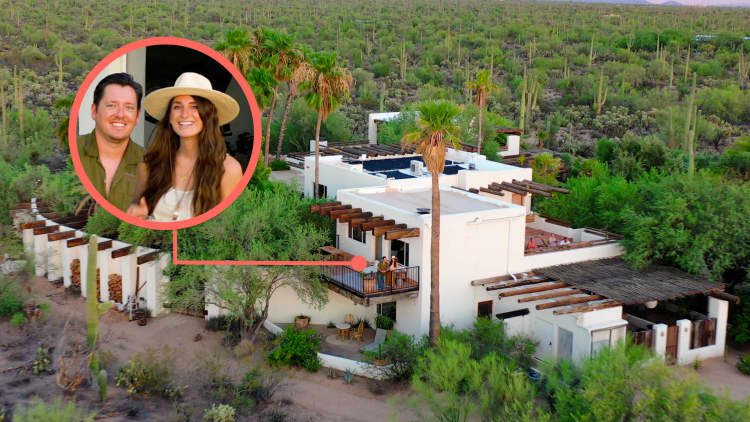
What would you give up to live affordably in New York City? Or to be minutes away from the beach in Santa Monica, California? In today’s expensive and hyper-competitive real estate market, some homebuyers are arriving at the same answer: space.
Between a marked uptick in rent and home prices and the disappearance of the classic “starter home,” young Americans are downsizing to afford to live in the places — and financial situations — they want.
CNBC Make it recently profiled three people making it work in less than 300 square feet. Here’s what it’s like.
‘People might call this place just a room or a closet, but to me, it is home’
In 2020, Alex Verhaeg moved into a 95 square-foot apartment in Manhattan’s East Village. He paid $1,000 a month.
“People might call this place just a room or a closet, but to me, it is home,” he told CNBC Make It in 2022.
The then-23-year-old barber, bike messenger and content creator found the apartment on Zillow and didn’t realize quite how small it was before he toured the place. At about 16 feet by 8 feet, Verhaeg’s apartment is smaller in area than an average parking spot, which comes in around 150 square feet. Rent has since bumped up to $1,100.
The place doesn’t come with a bathroom. Instead, residents share the three bathrooms and two showers located on each floor of the building. There isn’t much of a kitchen either. Verhaeg uses an electric cooktop that sits atop a dresser he uses for food storage.
“The main benefit of living in such a small space is that it makes you appreciate your things and be a minimalist,” he said. “You really can’t just go out and buy random things because you don’t have the space to store them.”
‘I only have one high-quality version of everything, and each item has its own place’
In 2022, in the wake of a breakup and a death in the family, Sung Yoo decided she needed a change. For the 40-year-old, that meant a cleanse of sorts, which saw her sell or donate most of her belongings, pack her winter items into storage and move to a 140 square-foot tiny home in Santa Monica.
Yoo’s home, which is situated in her landlord’s backyard, is an eight-minute drive from the beach. Rent, including utilities, runs her $1,600 a month — $600 less than the monthly median studio apartment in Santa Monica.
Although the home is “smaller than the average size of a parking spot,” Yoo wrote in a recent story for CNBC Make It, “it’s designed in a way that doesn’t feel cramped.”
Yoo’s main room has to serve multiple functions, acting as living room, closet and food prep area. Other than installing a few hooks, she’s left everything as-is.
The place doesn’t have a stovetop, but temperate Southern Califorinia weather means Yoo can use a double propane burner outside and cook at home at least six days a week.
Yoo has enjoyed the shift in lifestyle and expects to live in a tiny home forever.
“Living with intention in a tiny space has many benefits. I save time, energy and money (especially after getting rid of my $4,500 per-month New York apartment),” she wrote. “It’s very serene and grounding. I only have one high-quality version of everything, and each item has its own place.”
The tiny home out back: ‘As I stared out the kitchen window into my huge backyard, something clicked’
The tiny home lifestyle can even hold appeal for someone who already owns a full-size house.
In 2019, Precious Price bought a three-bedroom, 1,400-square-foot house in Atlanta for $196,000. The plan was to rent spare rooms on Airbnb. But that idea became moot when the Covid-19 pandemic hit, and Price found herself living alone in a house that felt too big.
“But that May, as I stared out the kitchen window into my huge backyard, something clicked,” she wrote in a piece for CNBC Make It earlier this year. “I could use that space to build a tiny home to live in, and fully rent out the main house.”
It cost around $35,000 to build the home, including the prefabricated shed structure, labor and material costs. Price sold stock to cover about $8,500 and put the rest on credit cards. When the tiny home was complete in 2021, she listed it on Airbnb to recoup the costs, charging between $89 and $129 a night.
These days, Price lives in the 296 square-foot tiny home and rents the larger house to long-term tenants. The rent on the big house more than covers the costs associated with both homes, “which means I’m able to live in my tiny home for free,” wrote Price.
Price makes efficient use of the relatively limited space. In addition to a lofted bed and a daybed that doubles as a couch, there’s a full bathroom, kitchen and breakfast nook. The kitchen even sports a full-sized fridge and extra-large sink.
And a tastefully and strategically decorated interior can give the impression of a much larger home, Price wrote.
“The eight separate windows, wall mirrors and glass shower door all make the space feel bigger. I sometimes forget I’m living in a shed.”
DON’T MISS: Want to be smarter and more successful with your money, work & life? Sign up for our new newsletter!
Get CNBC’s free Warren Buffett Guide to Investing, which distills the billionaire’s No. 1 best piece of advice for regular investors, do’s and don’ts, and three key investing principles into a clear and simple guidebook.
CHECK OUT: ‘The idea of a starter home has become more of a fairy tale’: How buyers find creative alternatives
